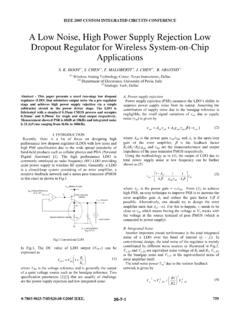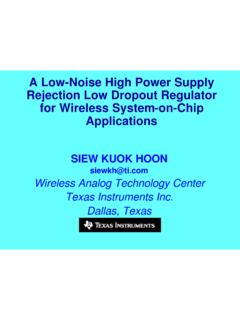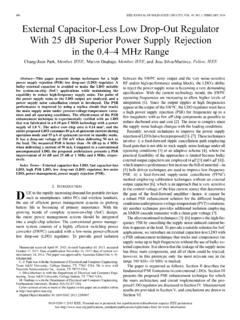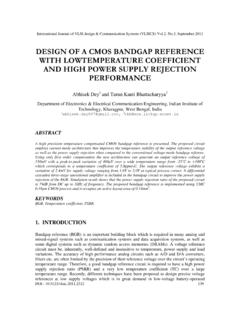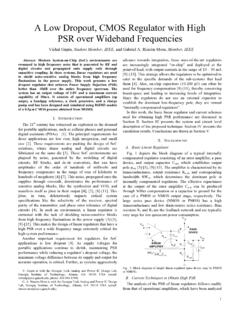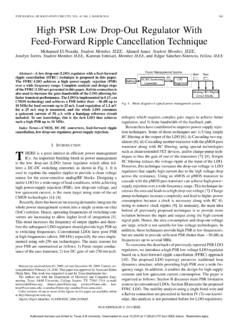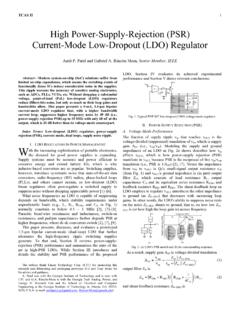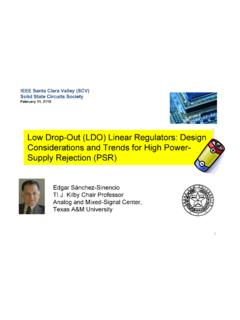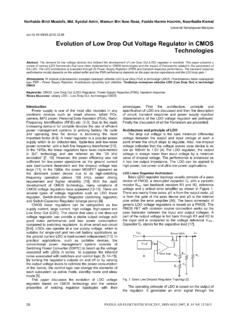Transcription of IEEE TRANSACTIONS ON MICROWAVE THEORY AND …
1 ieee TRANSACTIONS ON MICROWAVE THEORY AND TECHNIQUES, VOL. 55, NO. 10, OCTOBER 2007 2043. power supply rejection for RF Amplifiers: THEORY and Measurements Jason T. Stauth, Student Member, ieee , and Seth R. Sanders, Member, ieee . Abstract supply noise is a significant problem in RF systems where it can mix with RF signals, degrading signal/noise ratios and potentially causing violation of spectral masks. This paper presents an analysis of the supply rejection properties of RF amplifiers. We extend a conventional Volterra-series formulation to treat multi- port systems and use it to describe the mixing products between power supply noise and the RF carrier. It is shown that a multiport Volterra formulation can be used to treat weak nonlinearities in the system and that the nonsymmetric cross terms accurately predict low-order mixing phenomenon.
2 We demonstrate the validity of our hand analysis through the design and fabrication of a power ampli- fier in 180-nm CMOS, operating between 900 MHz GHz with Fig. 1. Effect of supply noise on RF amplifier output spectrum. a maximum output power of 15 dBm. Spectral regrowth of single- tone and EDGE modulation waveforms is shown to match within 1-3 dB across frequency and input signal power . Importantly, this analysis provides insight into the circuit-level mechanisms for sus- insufficient power supply rejection , supply noise can degrade ceptibility to power supply noise and can help designers improve system performance and even cause violations of the transmit the power supply rejection ratio robustness of system-on-chip wire- spectral mask [11]. The severe impact of supply noise on less blocks and transmitter architectures.
3 Wireless system performance makes it especially important to Index Terms dc dc converter, polar modulation, power am- understand the interaction of supply noise with RF amplifier plifier (PA), power supply rejection ratio (PSRR), RF amplifiers, supply noise. components for successful design of the system. In the context of supply noise upconversion, the Volterra se- ries (VS) analysis is a direct and powerful approach to achieve I. INTRODUCTION an analytical understanding of the circuit. Harmonic balance techniques can also be applied to study this problem, partic- T HE OUTPUT spectrum of RF amplifiers is highly con- strained by Federal Communications Commission (FCC). specifications and performance requirements. In transmitter ularly in simulation with Agilent's Advanced Design System (ADS) or Cadence Spectre's periodic-steady state (PSS) toolset [12].
4 While harmonic balance techniques are useful to deter- applications, the frequency content of the output signal must mine voltage and current waveforms in a mixed linear and non- conform to a spectral mask to avoid interference with adjacent linear system, solving the harmonic balance equation requires channels. Also, to guarantee an acceptable bit error rate (BER) knowledge of the input signal. Furthermore, the order of compu- across the wireless link, the error-vector magnitude (EVM) tation increases with the number of input harmonics. This makes of the modulated RF signal must be kept within tight bounds harmonic balance impractical for studying broadband perfor- [1]. In receivers, spectral leakage from noise or distortion can mance metrics such as spectral regrowth and adjacent channel degrade the signal-noise ratio (SNR) and can cause desen- power ratio (ACPR), especially for real wireless systems with sitization or cross-modulation [2], [3].
5 Traditional distortion nonperiodic amplitude waveforms. In this regard, VS has the analysis has focused on near-band spectral regrowth caused by following advantages. interaction of the input signal with amplifier and component VS can describe the linear and nonlinear dynamics of a nonlinearities [4] [10]. However, an additional source of spec- circuit without knowledge of the input signal (provided that tral leakage comes from noise or voltage ripple on the power the circuit remains in a weakly nonlinear regime). supply . As demonstrated in Fig. 1, spectral energy injected The Volterra kernels can provide a compact expression of from the power supply can mix with the RF carrier and be the time- and frequency-domain behavior as a function upconverted to near-band frequencies. If the RF amplifier has of physical device parameters, independent of the input waveform.
6 Manuscript received April 9, 2007; revised June 17, 2007. This work was The circuit is solved only once (in contrast with harmonic supported in part by the University of California under the Micro Program and by Panasonic. balance, which may need to reiterate for different input The authors are with the Department of Electrical Engineering and Computer waveforms). Science, University of California at Berkeley, Berkeley, CA 94720 USA (e-mail: VS analysis allows rapid computation of multitone and broadband behavior, as in [7], and is one of few simula- Color versions of one or more of the figures in this paper are available online at tion techniques that is practical for rapid computation of Digital Object Identifier spectral regrowth phenomenon. 0018-9480/$ 2007 ieee . 2044 ieee TRANSACTIONS ON MICROWAVE THEORY AND TECHNIQUES, VOL.)
7 55, NO. 10, OCTOBER 2007. VS is effective in the context of supply noise because noise tion to treat RF amplifiers with memory. Section III describes sources are typically small-signal relative to the operating point the target problem and the method for characterizing the non- of the amplifier. In the layout, common sources of supply noise linearities in the CMOS amplifier. Section IV presents Volterra include magnetic coupling to bond wires and power supply in- operators for the supply intermodulation sidebands. Section V. terconnect, electrostatic coupling between nearby traces, and compares hand analysis to simulation and experimental results. current noise from analog or digital blocks passing through par- Spectral regrowth is compared for single-tone and EDGE modu- asitic inductance and resistance in the power rails [13].
8 supply lated signals operating in the traditional 900-MHz band, as well noise may also be directly injected into the system by the voltage as at GHz. regulator [14] [21]. In these cases, supply noise is typically less than 10% and often less than 1% of the dc supply voltage level. II. THEORY OF MULTIPLE-PORT supply INTERMODULATION. With small supply noise amplitude, linear amplifiers typically power supply noise can mix with the RF carrier and be up- remain in the weakly nonlinear regime. In this case, VS can converted to the nearband spectrum. This process happens when often predict performance over many decades of power of the the amplifier has stray paths that couple the supply voltage to RF input signal. nodes in the amplifier that modulate the amplitude or phase of It is important to note that many of the important sources of the transmitted signal.
9 At high frequencies, it may be easy to supply noise are low frequency relative to the RF signal. Such filter supply noise with choke inductors or bypass capacitors. It noise sources are difficult to filter because at low frequency, may be more difficult to filter low-frequency supply noise due to bypass capacitors are less effective. With low-frequency noise limitations on the size of filter elements. Low-frequency supply signals, mixing products tend to be more problematic since noise is also problematic because the first-order intermodulation they create in- or near-band frequency content. As a particular terms may be close to the band of interest. example, in polar and envelope tracking (ET) transmitter ar- Analysis of supply -carrier intermodulation is complicated by chitectures, the voltage regulator modulates the supply voltage the dynamics and nonlinearities of the system.
10 If the RF ampli- synchronously with the envelope of the transmitted signal. fier circuit does not have memory, the distortion products can Many implementations use switching regulators to improve be analyzed in a straightforward manner with traditional power the efficiency of the transmitter across the range of opera- series analysis [1], [2]. This may be the case if the effects of tion [16] [21]. While this can significantly increase average reactive elements are not significant or can be easily included efficiency, switching regulators produce noise on the power between stages that have purely conductive or resistive nonlin- supply at the switching frequency fundamental and harmonics. earities. Such may be the case in a circuit with only diode or Switching noise is usually low frequency compared to RF transconductance nonlinearity followed by a reactive filter.


